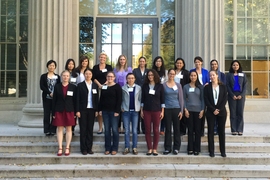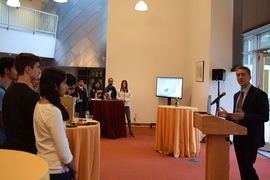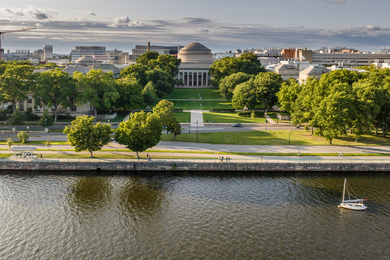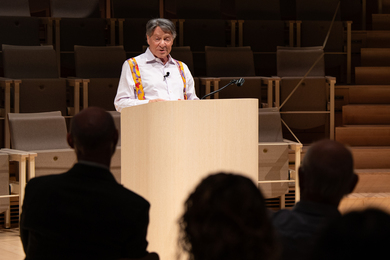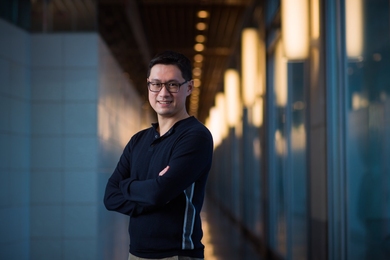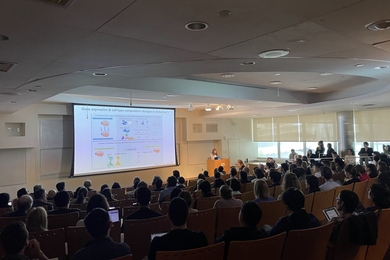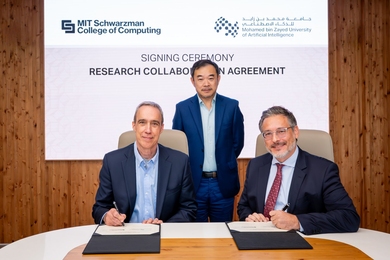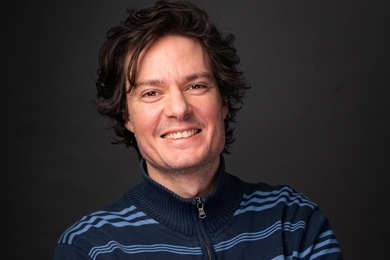The Department of Civil and Environmental Engineering (CEE) faculty opened their research labs during this year’s Independent Activities Period (IAP) to freshmen as part of a CEE initiative — known as mini-UROP — which functions like a compacted Undergraduate Research Opportunities Program (UROP). As the program has evolved, the organizers quickly realized opportunities to extend program benefits to include wonderful new ways to build community.
“This year we added new projects to not only build hard science and engineering skills, but also activities to develop soft skills like collaboration and networking,” said grad student Fatima Hussain, one of the program organizers. “Now students leave the labs also knowing who the current CEE students are, what graduate students and postdocs do, and which CEE faculty they may pass in the hallways every day. A richer UROP experience like this better prepares students for their time at MIT and future professional careers.”
Co-organizer and graduate student Julia Hopkins added that it is equally important for the grad students and postdocs to hone their interpersonal and teaching skills. “We paid extra attention this year to support the mentors as they experimented with coaching techniques to best guide their protégés,” she said.
In all, 18 of MIT’s newest recruits were paired one-on-one with CEE grad students and postdocs to experiment on a broad range of research projects, including ecological experiments on coastal vegetation, organic materials structure analysis, and large-scale network transportation and utility challenges.
Adding and removing guardrails
This year’s mini-UROP was offered as a six-unit subject that required students to work at least 30 hours per week for four weeks. At the program’s conclusion, each student gave a five-minute lightning-round presentation to the entire class.
Preparation started in December with CEE graduate students and postdocs presenting about two dozen research projects from the built and natural environments. Students then ranked and rated their project preferences and were matched as best as possible to their interests.
Just after the new near, a kickoff lunch quickly brought everyone together to compete in groups on a challenge to innovate water preservation solutions. Weekly “chalk talks” from the mentors followed, showcasing the interdisciplinary nature of much of CEE’s research while allowing students to converse informally in small groups.
Adding structure to the weekly lunches at the outset to provide context and form — then easing back to allow students freedom to make decisions, compare notes, and work independently or with mentors — was an approach the team chose in order to help participants make the most of their experiences.
Developing new perspectives
“What interested me most was the opportunity to explore what’s available within the Civil and Environmental Engineering department,” said freshman Grace Melcher. “It gave me the chance to get real lab experience and learn more about the variety of different topics covered in Course 1 [CEE]. My opinion about Course 1 changed now that I know about the huge flexibility of a Course 1 degree.”
Melcher worked with Stefan Thiele in Professor Martin Polz’s lab to study amoeba “grazing” rates on different strains of bacteria from the Vibrio genus. She used 44 strains of V. breoganii grown in single streaks on plates, and measured the length of the amoeba’s grazing path to determine the predation fitness of different bacteria strains. Understanding how bacteria guard against predation is important in the fields of microbial ecology.
“A lot can happen in one IAP,” said freshman Isabella Gomez. “I am interested in working with infrastructure policy in the future to create sustainable cities. I originally thought I would pick another major, but now I know I want to double major in Course 1 and Course 17 [political science].”
Gomez worked with CEE mentor Carlos Lima Azevedo of Professor Moshe Ben-Akiva’s lab to better understand mobility in Boston by using CEE’s new simulation platform, SimMobility, and public, anonymized data points from the 2010-2011 Massachusetts Travel Survey. Gomez prepped the data for simulation and was able to illustrate how certain attributes like a traveler’s age, income, or employment status influenced modes of transport, routes, and numbers of trips taken. Knowing what’s driving traffic patterns can help urban planners modify behavior through innovative strategies like targeted incentives.
Freshman Alex Denmark researched under the guidance of Neha Mehta in Professor Charles Harvey’s lab on evaluating the toxicity of fracking wastewater, a hot topic these days for scientists, engineers, and citizens of countries using this natural gas extraction technique. Denmark deployed a leaching experiment to generally understand the mechanisms involved with metal mobilizing in fracking. Trace metals like uranium, arsenic, and cadmium that are released during fracking can be detrimental to human health.
Freshman Susan (Daly) Wettermark intends to work in industry someday, possibly in the energy field. She said the mini-UROP experience helped her realize that a lot of the mentors came from different backgrounds like mechanical engineering or biology to do work in CEE. “I love that there are opportunities in CEE for people with all kinds of interests and backgrounds,” she said.
A good example of industry crossover was her experiment on mechanical testing of composite materials, overseen by mentor Grace Xiang Gu, a PhD student working in Buehler’s lab. Wettermark wanted to uncover ways a material with weak components — like shell or bone — can be so tough. She experimented to replicate these materials using 3-D printing and exposed the geometry that maximizes toughness while minimizing complexity. Insights into materials properties have many applications in biomedicine and structural building design.
Annie Hughes worked in Assistant Professor Benedetto Marelli’s lab on 3-D printing of biopolymers to tackle perishable food preservation challenges. She explained that 50 percent of fruit is lost in the transition from farm to table. She helped engineer an edible coating made of natural silk polymers suspended in water and designed an ultrasonic system to spray the solution on fresh strawberries. Preliminary results showed the fruit degraded less over time compared to a control group without the coating.
“It was a wonderful experience to learn engineering skills at the interface between biomaterials and fluid mechanics,” she said. “I now better appreciate food engineering and ways this type of innovation might help feed more people and reduce waste.”
“The mini-UROP represented an amazing opportunity for freshmen to spend their IAP learning the bread and butter of research,” Marelli said. “The freshmen year is always unique, but including a full-month of research experience definitely adds a more distinct flavor to it.”
Fostering student experiences
“Fostering student experiences is central to our educational mission,” said Markus Buehler, CEE department head and the McAfee Professor of Engineering. “It’s an incredible testament to our faculty’s culture of openness that we’re able to bring students into real labs — often for the first time in their lives. That’s why Fatima, Julia, faculty, and staff have taken such care with the development of this mini-UROP specifically designed for freshmen.”
Freshman Mark Mockett used his experience with graduate student Derek Chang of the Resilient Infrastructure Networks Lab to analyze traffic patterns from two parallel freeways in the San Francisco Bay Area.
“I had no formal understanding of how traffic worked, so I thought it would be really interesting to study it.” Mockett said he learned new MatLab software to help crunch large data sets and became a convert to the stochastic process which states that randomness is key to good modeling.
Freshman Marissa Steinmetz was intrigued with the opportunity to learn about urban systems like water distribution networks. For example, engineers often are hired by companies to help them save money or anticipate utility disruption or disasters. Steinmetz also worked with Chang, and focused her research on identifying stress points in water pipes for potential breaks. She interpolated results from public data about pipes ages, angles, and pressure loads and layered the data to help visualize and analyze where failures in a network most likely would occur.
“The mini-UROP projects are classic examples of the new-age civil and environmental engineering in action,” said Assistant Professor Saurabh Amin. “Students immersed themselves in projects that are at the frontier of technology, focused on the underlying scientific concepts in operation, and learned to appreciate the practical deployment challenges in real-world scenarios. This abstraction of big engineering problems into carefully crafted mathematical models — and translation of the design based on these models into validation experiments — is what sets the CEE mini-UROP apart from many other IAP activities.”
A great sign of success from this year’s mini-UROP is that almost half of the students are continuing on as full UROP students this spring. As they extend their hands-on research through May, they know now what to expect and that there is always a strong network of support available to help them along their way.






